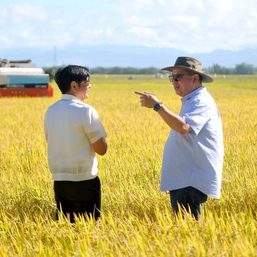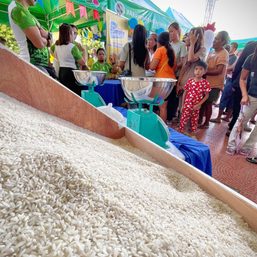SUMMARY
This is AI generated summarization, which may have errors. For context, always refer to the full article.

MANILA, Philippines – Rice inflation in September hit 17.9%, its highest point in 14 years, even as President Ferdinand Marcos Jr. tried to clamp down on soaring prices.
Rice inflation hasn’t gone beyond that level since March 2009, when it hit 22.9%. Last August, rice inflation was measured at just 8.7%.
This comes even as Marcos set a nationwide price cap of P41 per kilo for regular milled rice and P45 per kilo for well-milled rice. The restrictions took effect on September 5 and lasted throughout the month.
However, National Statistician Dennis Mapa noted that the price caps led to “mixed” results.
“Mixed ngayon result doon sa compliance na nakita namin sa price cap. May mga outlets na nagkaroon, may mga outlets naman na puwedeng may isang variety sila doon sa P41 for regular-milled or P45 [for well-milled rice] pero ‘yung ibang varieties nila ay mas mataas,” Mapa said during the September inflation press conference on Thursday, October 5.
(We observed mixed results when it came to compliance with the price cap. Some outlets followed it, while some outlets had varieties that they sold at P41 for regular-milled rice or at P45 [for well-milled rice], but they also had varieties that they sold at higher prices.)
Given the high inflation for rice, did the price caps work? Based on the monitoring done by the Philippine Statistics Authority (PSA), many retailers didn’t follow them.
The PSA found that of the 2,601 varieties of regular-milled rice that it monitored, only 640 fell within the price cap range. For well-milled rice, only about 20% of varieties were in compliance, or 687 of the 3,498 varieties monitored.
The PSA also noted that the national average prices for 1 kilogram of rice were higher than the price caps. Here is a table comparing the prices:
| Variety | Price ceiling | September average price | August average price |
|---|---|---|---|
| Regular-milled rice | P41.00 | P47.50 | P43.30 |
| Well-milled rice | P45.00 | P52.70 | P47.63 |
| Special rice | None | P61.10 | P56.30 |
Mapa explained that during the early days of the price ceiling’s implementation, many retailers that they monitored were selling at higher prices because they were finishing up their stocks of regular and well-milled rice.
But asked whether the PSA could categorically say that the price caps were ineffective, Mapa said more research would be needed to determine how bad rice inflation could have been if no ceiling was introduced in the first place.
Marcos lifted the rice price caps on Wednesday, October 4, after the Department of Agriculture and the Department of Trade and Industry both recommended the move, citing stable supply and inventory levels.
Marcos had made a campaign promise to bring rice prices down to P20 per kilo – a goal that has been met with criticism and described as unrealistic.
Overall, inflation jumped to 6.1% in September, driven largely by rising food and non-alcoholic beverage prices, particularly among cereals and cereal products. Rice falls under this category. – Rappler.com
Add a comment
How does this make you feel?
![[Vantage Point] BBM Year 2: Hits and misses](https://www.rappler.com/tachyon/2024/06/thought-leaders-marcos-hits-and-misses.jpg?resize=257%2C257&crop=277px%2C0px%2C720px%2C720px)


![[In This Economy] Part 2 | POGOnomics: Are we banning POGOs out of fear, outrage, not rational thought?](https://www.rappler.com/tachyon/2024/06/thought-leaders-pogonomics-part-2b.jpg?resize=257%2C257&crop=292px%2C0px%2C720px%2C720px)
![[In This Economy] POGOnomics: Weighing the costs and benefits of POGOs](https://www.rappler.com/tachyon/2024/06/thought-leaders-pogonomics-part-1.jpg?resize=257%2C257&crop=279px%2C0px%2C720px%2C720px)

![[ANALYSIS] How one company boosts farmer productivity inside the farm gate](https://www.rappler.com/tachyon/2024/06/bioprime-farmgate-farmer-productivity-boost.jpg?resize=257%2C257&crop=465px%2C0px%2C1080px%2C1080px)


![[ANALYSIS] The department of ambivalent, if not ambiguous agriculture](https://www.rappler.com/tachyon/2024/05/department-of-ambivalent-05252024.jpg?resize=257%2C257&crop=279px%2C0px%2C720px%2C720px)
There are no comments yet. Add your comment to start the conversation.